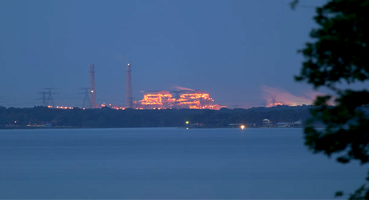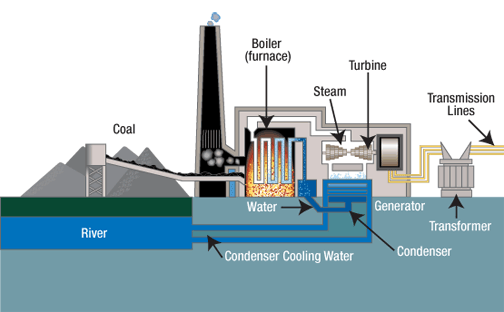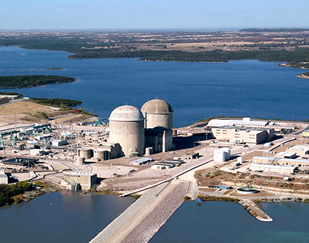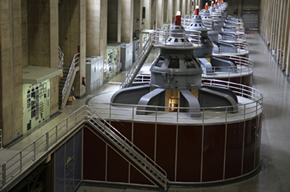
We’ve all heard you are not supposed to mix water and electricity, but did you know that the electricity
you use in your home every day almost certainly depends on water to be generated?
It may seem counterintuitive, but much of the electricity generated in Texas requires that water be used
in the process. Coal or gas, nuclear and hydroelectric plants all require a steady supply of water to function.
The Brazos River Authority, tasked by the state to manage water in an entire river basin, stores and
sells water for a variety of uses including drinking, agriculture, industry, municipal, and environmental needs. Nearly half of the Authority’s water contracts
are with power companies. In fact, two of the Authority’s lakes, Granbury and Limestone, were built for the primary purpose of providing water for electric generation.
Lake Granbury was created in 1969 with funds from an agreement with Texas Utilities Company (now Luminant) to
supply cooling water for a gas-fired power plant on the lake and for the nearby Comanche Peak Nuclear Power Plant. Lake Limestone’s completion in 1978 was made possible as a
result of agreements with both Luminant and Houston Lighting and Power (now NRG). In both cases, those agreements covered the entire construction cost of the lakes.
With the Texas State Data Center predicting Texas’ population will grow by more than 11 million people by 2040,
the need for electricity and the additional water to operate the plants will continue to increase. Here’s a look at some of the ways electricity is produced and the role
played by water.

Coal and gas fired power plants
The process at these plants begins with the burning of fossil fuels, either coal or natural gas and sometimes
fuel oil, to generate heat. Because these plants require a steady supply of combustible materials to continually generate power, they are often located either near
a coal mine or gas field, or with immediate access to rail transportation for coal shipped from outside of Texas. Similarly, they are usually located near a lake
or other reliable source of water.
The fuel source is fed into a furnace to help keep an intensely hot fire burning. Meanwhile, purified water is
pumped into a connected boiler, where it is turned into steam and sent under high pressure to a turbine. The pressurized steam causes the turbine’s blades to spin,
turning a generator to create electricity.
Once the steam has done its work in the turbine creating “spent steam,” it contains waste heat that cannot be used
in the generation process. Cooling water from the lake is used to remove the waste heat from the power plant.
As the steam is cooled it condenses and is returned back to the boiler to repeat the process. In most cases, cooling
water is returned to the lake from which it was drawn to release the waste heat into the atmosphere by evaporation. In some cases, the power generation process uses up
all of the water.

Nuclear power plants
In a general sense, nuclear power plants use water in a similar way as their fossil fuel burning cousins.
However, nuclear plants rely on a fission chain reaction to generate heat. This takes place using radioactive materials in a carefully sealed chamber called a reactor.
Water is pumped through the reactor, where it heats and then is pumped in a closed system through a tank holding more water.
The heat causes the water in the tank to turn to steam, which is sent through a turbine, turning a generator
to make electricity.
Again, as the cooling water condenses it can be pumped back through the system. The uncontaminated water used in the
cooling process can be returned to the nearby lake or other source. The steam and cooling water are never mixed because the water that passes through the reactor becomes
radioactive.
In the case of the two existing nuclear units, water taken from Lake Granbury is piped to Squaw Creek
Reservoir and is then used to cool the plant. Some of the returned water is released into Squaw Creek and returns to the Brazos River downstream from Lake Granbury.
Two new planned reactors will use cooling towers and are planned to return cooling water back to Lake Granbury.

Hydroelectric power plants
Hydroelectricity is overall the simplest method of electric generation mentioned here, because water is the
only resource required to make it happen.
Water held in a reservoir by a dam is pushed by gravity through the plant’s powerhouse, where it turns a
turbine and electricity is created in a connected generator. In this type of operation, the water never really leaves the river system.
The Authority’s Possum Kingdom Lake was impounded with a dam built to generate hydroelectricity.
That power plant, however, is currently not operational.
So remember, the next time you leave a room without turning off a light, your utility bill may not be the only
thing affected. Generating the electricity to keep that light on uses one of our most precious resources: water.